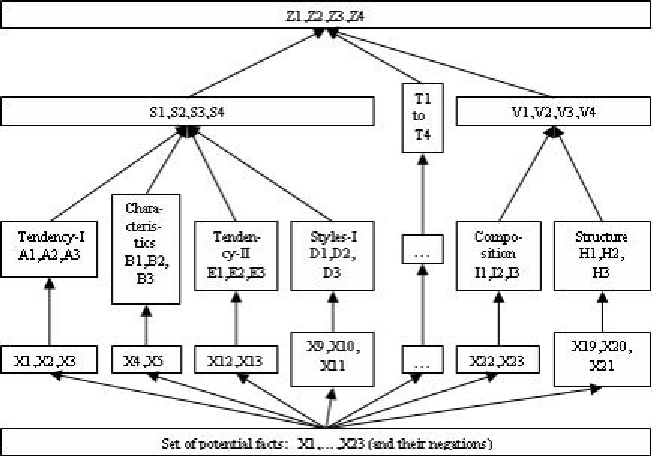Information Technology Reference
In-Depth Information
Table 2. A first level table
X17 (continuous bass), X18 (melody), and their
negations, constitute the class “
components of
the structure of the music work
”. The identifiers
that in this chapter have been chosen to form
these five classes are listed in Table 1 (the nega-
tion of the Xi (I = 1, …, 23) are omitted for the
sake of space). These classes shall be used both
as frameworks for constructing the tables from
which production rules will be written down and,
later on, in the GUI.
X3
¬X3
X1∧X2
A1
A3
¬X1∧X2
A2
A3
X1∧¬X2
A1
A3
¬X1∧¬X2
A2
A3
first level production rules
In a first stage we write what will be called “first
level production rules” by building tables that
relate potential facts with different Baroque,
Rococo and Classic properties. For the sake of
space and because all first level tables are built
the same way, we only show in detail in this sub-
section, the first and the next to the last first level
tables, together with their correspondent sets of
production rules.
The first one of the first level tables, Table 2,
relates the three characters, X1, X2 and X3, to the
symbols: A1 which means “Baroque
tendency
I
”
,
A2 which means “Rococo
tendency
I”, A3 which
means “Classic
tendency
I” (Table 2). The assigna-
tions A1, A2 and A3 are decided by experts.
construction and description of the
rB of es1
As already said, the RB remains unchanged
whatever is the score being examined for its
style characterization. The reason is that RB is
a formal description of the characteristics of the
musical period under consideration, but not of a
particular score, while each score is described by
one subset A of F. The RB of SE1 consists of 370
production rules (ES2 and ES3 consist of 706 and
923 respectively).
The process of construction of the RB of ES
is explained in detail next and is summarized in
the flowchart of Figure 1.
Figure 1. Flowchart of ES1










Search WWH ::

Custom Search